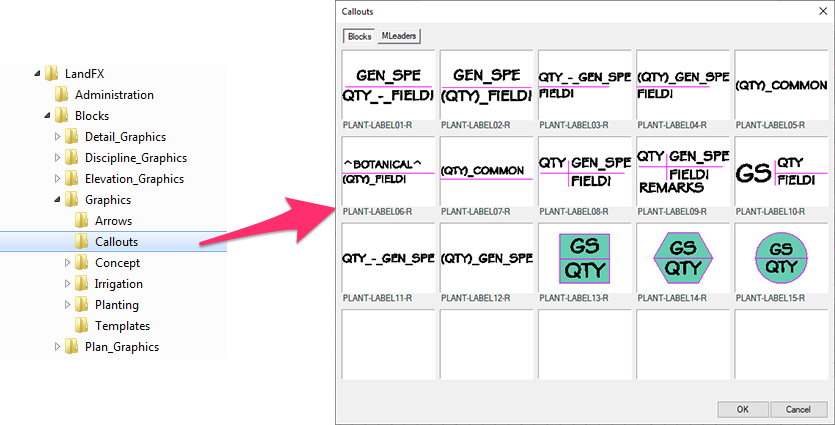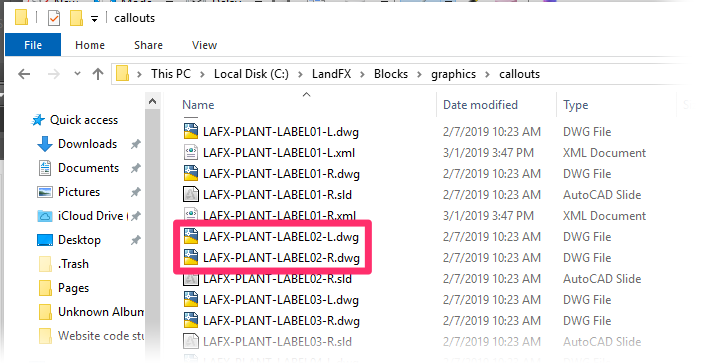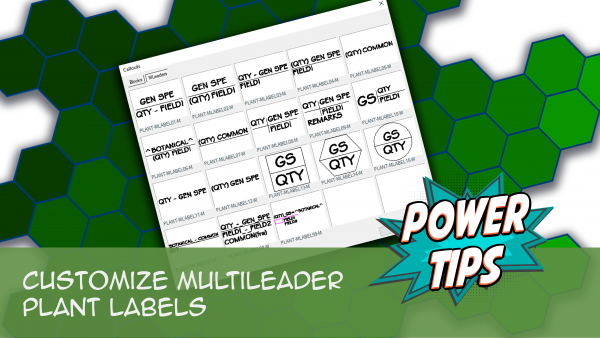
Edit Our Default Plant Label Styles
Quick video
- Plant Callout Block Location
- Editing & Saving
- Editing & Saving MLeader Styles
- Updating an Existing Block Label Style to Work With MLeaders
- Creating or Editing an Mleader Label Style with Text
- Setting the MLeader Style in Each Drawing
- Editing & Saving Block Label Styles
- File Naming
- Plant Labels & Attributes
- Creating a Label Text Style for Plant Common Names in an Additional Language
- Save a Preview Thumbnail
- Change the Insertion Point of the Plant Labels
- Test Your Edited Label Style's Functionality
- Apply Your Edited Label Style to a Previously Labeled Plan
- Related Webinars
- Troubleshooting
Before you overwrite one of our default plant label blocks, we recommend creating backup files of the original. Note that plant label blocks must be saved in a specific manner to allow the software to recognize them. If you wish to create your own, you will also need to abide by this standard.
We updated our default plant labels in March 2019, adding styles that use MLeaders and improving the block-based label styles. You may not have these updated label styles. To access these styles, you'll need to delete all existing default plant label blocks and slides. For instructions, see our Updated Plant Labels documentation.
Our plant labels now allow plant codes within parentheses.
Plant Callout Block Location
By default, Plant Callout variations are saved in the folder LandFX/Blocks/Graphics/Callouts.


You can easily open the callout files from within the Planting Preferences screenby selecting the label you want to edit and clicking Open Label Files.
Editing & Saving
Before you overwrite any of our default plant label styles, we recommend creating backup files of the original. Note our plant label source files must be saved with specific filename formats for the software to recognize them. If you want to create your own, you'll also need to abide by these standards.
Editing & Saving MLeader Label Styles
Our MLeader label styles will each have two source files – one for Imperial and one for metric. Unlike our block label styles, the source files for our MLeader styles do not have right (-R) and left (-L) versions.
The names of MLeader files will begin with the characters LAFX-PLANT-MLABEL. The metric version will end with -M. The example to the right shows the Imperial and metric versions of the MLeader version of our LABEL02 style.

Open the source file of the MLeader label style you want to edit, make your changes, and save it. Note that both versions will be unitless when opened but will be different sizes.
If you design in both Imperial and metric units, take care to edit both versions.
Recommendations, requirements, and other notes for MLeaders:
- Labels must be symmetrical.
- Labels must have a line through them to connect to the leader because of a current CAD flaw where background masks inside a mleader's block won't mask the mleader's leader lines.
- Labels must include an object other than a multi-line attribute on at least one side of the insertion point (0,0) because of a current CAD limitation that affects automatic flipping logic when moving the MLeader. Annotations spanning both sides won't fix the issue. This object can be just a tiny circle, and it can be non-plot.
- All our MLeader styles contain multi-line attributes and have a dynamic background mask by default.
Quick video
Save your changes to the MLeader callout source file using our Save Block tool.
Updating an Existing Block Label Style to Work With MLeaders
If you've created a custom block label style and you want to update that style to work as an MLeader, you'll have to complete some specific steps. Here's what to do.
Creating or Editing an Mleader Label Style with Text
If you create a multileader (MLeader) file with more than one attribute object, or including any other object such as a line, Land F/X will create a plant label style as an MLeader with a block.
If you create an MLeader file with only one attribute, or only one MText object, Land F/X will create a plant callout as an MLeader with mtext. If you underline a line of the text, Land F/X will create a connecting line in the multileader label too. Our default MLabel styles 03, 04, 06, 11 & 12 use this technique already, so you can use those styles to edit or reference to make your own.
Setting the MLeader Style in Each Drawing
If you want to set a specific MLeader style in each drawing where you use your MLeader labels, first place the MLeader callout you plan to use in that drawing. Then type MLEADERSTYLE in the Command line and press Enter.
Under the Content for that style, you can configure the settings. For example, if you don't want your callouts to left justify, uncheck the Always left justify option.
Keep in mind that you would need to set the MLeader style in this way in each drawing where you plan to use your MLeader style.
Editing & Saving Block Label Styles

Each of our block-based plant label styles is controlled by two DWG files (Left Callout and Right Callout).
The filename of the left source file will end in -L, and the right one will end in -R.
Don't forget to edit both the -L and -R versions of any style you want to edit.
We updated our block label styles in 2019. These updated styles have some new features, including also have background masks. How to get our updated block label styles
Remember to verify the insertion point of each block label style.
- The insertion point for a -L (left) callout is at the right end of the line where the callout will attach.
- The insertion point for a -R (right) callout is at the left end of the line where the callout will attach.

Save changes to both the Left and the Right callouts separately by using our Save Block tool.
File Naming
Plant label source files have to be saved in a specific way, depending on whether you're editing an MLeader or block label style:
- MLeader styles: Filenames must begin with LAFX-PLANT-MLABEL## (where ## is the callout number) Filenames of metric MLeader styles must end in -M.
- Block styles: Filenames must begin with LAFX-PLANT-LABEL and be saved with a name such as LAFX-PLANT-LABEL##-L and LAFX-PLANT-LABEL##-R (where ## is the callout number).
Make sure to justify text for the left and right versions of block label styles accordingly.

Save a Preview Thumbnail
After you've modified plant labels, you may want a more pleasing preview thumbnail of the callout to replace the attribute name with an example value.
- MLeader label styles: Open the single source file for your label style.
- Block label styles: Open the right (-R) source file for your label style – that is, LAFX-PLANT-LABEL##-R.dwg.
Zoom to Extents. Then use the AutoCAD MSLIDE command to shoot and save a preview of the drawing file.
Plant Labels & Attributes
As "smart" blocks, plant labels contain on dynamic pieces of text called "attributes." Because plant labels contain attributes, they are able to "read" information about plants in your drawing and reflect that information automatically.
Our plant label system relies on a specific set of attributes. If you edit a plant label, or create your own, you'll need to be aware of these attributes. For more information, see our Attribute Definitions for Plant Labels page.
Creating a Label Text Style for Plant Common Names in an Additional Language
You might need to create a plant label style that lists plant common names in an additional language. For example, you might normally work in English but have a client who requires plant names to appear in Chinese. The following steps show how to create a label style that can list plant common names in an additional language.
1. With the correct Preference Set active, open the Planting Preferences screen.
Click the Open Label Files button.

2. In the single file that opens for an MLeader style, or in the -R label file (the right label) for a block label style, open our Text tool from the F/X Site ribbon. Create a new Text Style for the font you want to use. Having trouble seeing your font? Solution >
3. Place a text entry using the new Text Style you created. This step will define your Text Style in the label drawing. (This is just a “dummy” text entry that you can delete afterward – you just need the definition for now.)

4. For your attribute in the additional language, select the attribute item. In the Properties panel, change the Style to your new font style.
Need to open the Properties panel? Type Properties in the Command line and press Enter.
5. Also in the Properties panel, select Yes from the Multiple Lines menu. This step will allow the attribute to follow this desired Text Style.
6. Save the label file.
7. Repeat steps 3 through 6 in the -L file (the left label). The new Text Style you created will already be available from our Text tool, so you just need to place a dummy text to define the style in the left label drawing.
Change the Insertion Point of the Plant Labels
If your fonts, leaders, or other components of one or more of your plant labels are coming in at the wrong location, you may need to change the insertion points of the labels.
Test Your Label Style's Functionality
1. Open a blank drawing.
4. Open the Plant Manager, and add any tree to your project. Select any symbol for the tree.
5. Place the tree in the blank drawing.
6. Label the tree using our Label Single Plant tool. If you're using a block label style, label the tree from both the left and right sides.
7. Confirm that your edits were successfully saved to both label blocks.
Apply Your Label Style to a Previously Labeled Plan
MLeader Style
The only way to use an MLeader label style in an existing plan that's already labeled is to relabel the plan.
Block Style
To use your customized block label style on an existing plan, you can simply open that plan and select your new or edited label style in the Planting Preferences. Your new style will replace the old one throughout the drawing
However, if you've edited one of our label styles and you've already used that style in a plan before making your edits, you'll need to complete the following steps to replace the original style with your edited version.
Why won't your plans update automatically?
If a plan has been previously labeled, the label style that was originally used in the plan will alread be defined in that drawing. Before you can apply the new version to a drawing, you'll need to purge the old version from that drawing.
1. Open the previously labeled drawing file.
2. Open the Planting Preferences, and click the current label style.
Important: Refer to your office CAD manager before continuing with these steps. The next few steps will affect anybody in your office who is currently labeling plants. You also may be locked from editing your office's Preferences.


3. Select any other block label style in the Callouts dialog box, and click OK.
Click OK in the Planting Preferences.
The labels in your drawing will automatically switch to the style you selected.
4. Type PRG in the Command line and press Enter. The existing block definition for the original label style will be removed from the drawing.
5. Open the Planting Preferences again. Change the label style back to your edited style. The new style will now be properly defined in the drawing.
Related Webinars
- Implementing Your Office CAD Standards: Find out how easily you can adapt your own office standards to Land F/X – and how effectively the software will then apply them to your projects. (1 hr 2 min)
- Planting F/X Setup: If you're trying to make Planting F/X work with your firm's existing style standards, this webinar is for you. (58 min)
- Working With Blocks: Take a broad look into the role of blocks within Land F/X and how to integrate your personal set of blocks into our system. (1 hour 4 min)
Troubleshooting
Issue: Can I change my plant label callouts to common names instead of botanical?
Issue: Rescale plant labels after setting the drawing scale
Issue: Plant labels are losing their association (connection) with plants
Issue: Correcting scale in planting callouts
Issue: Some of my plant labels are not resizing (rescaling) when I rescale my drawing
Issue: You are experiencing text wrapping issues with multileader (MLeader) plant labels
Issue: You want to create asymmetrical multileader (MLeader) plant labels
Issue: You want to convert a non-MLeader plant label style (aka a block style) to MLeader style

Our software tailors AutoCAD®, Revit®, and SketchUp® to the needs of landscape architects, irrigation designers, and other professionals. We automate your most tedious tasks and ensure accuracy, giving you more time to design.






